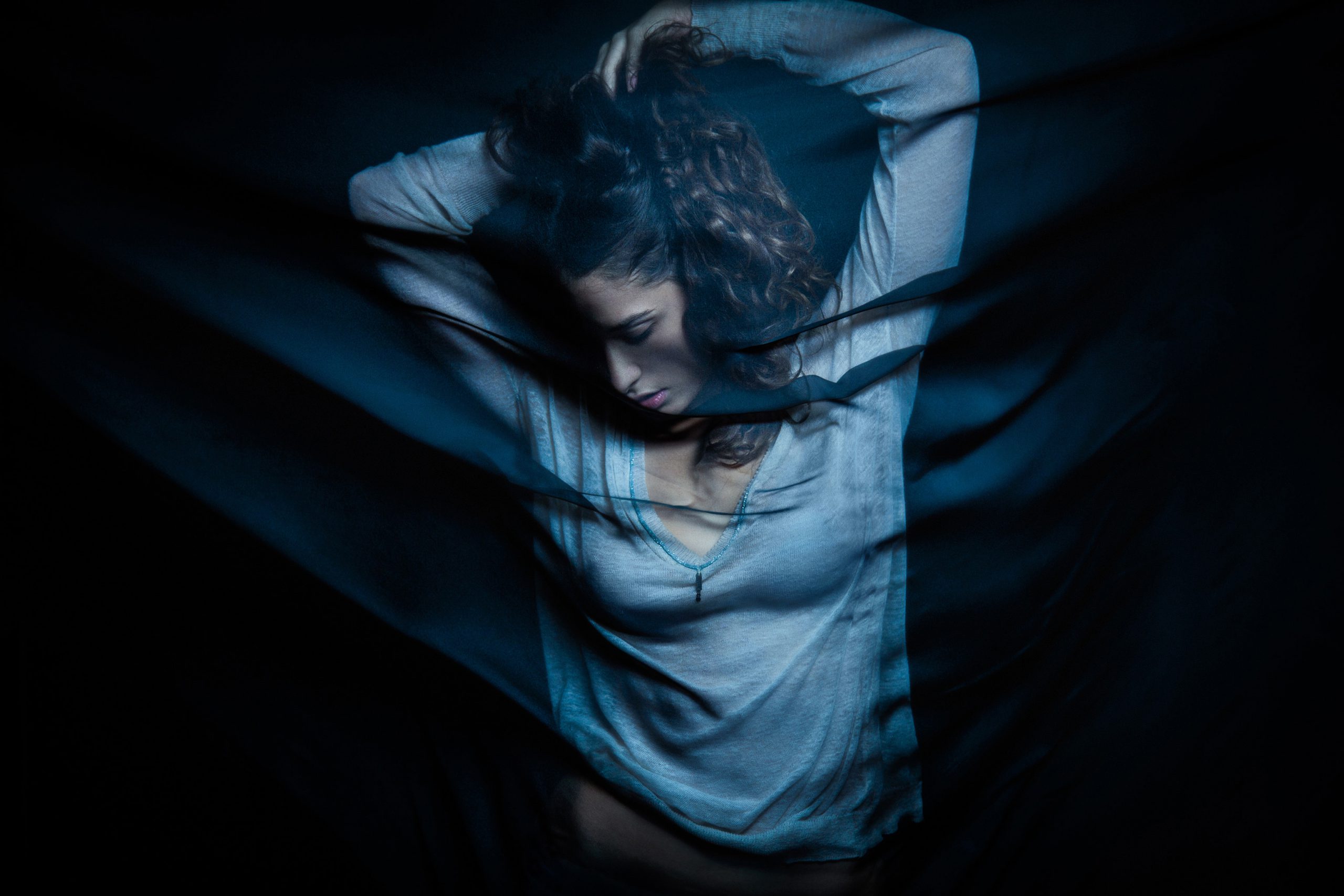
One of the many admirable qualities of “After (A Love Story)” is how a 14-minute short about a therapy session can still feel complete, emotional, and complex, even though, in reality, the session likely went on a lot longer. Despite the time constraint of the piece, we still get a real sense of the backstory, the difficulties in the present day, and a possible future for Charlie (Glenn Stanton) and Edie (Alyssa Thordarson), who have been navigating a traumatic event and its effect on their relationship. The film, written by Thordarson and directed and edited by Clare Cooney, brings us into a moment of their life together, one that feels clear, lived-in, and with everything they have as a couple at stake.
“After” tells the story of Charlie and Edie’s first session with a therapist (Susan Jamshidi) following a home invasion that happened many months ago, leaving both of them scarred in different ways. We never see the event, but we hear sounds and eventually piece together that Edie was assaulted while Charlie lay helpless. Since then, Charlie has been unable to touch Edie intimately and meaningfully. He can’t even look at her, a side effect that has more to do with the shame he feels in not being able to help her and wishing he could go back in time and do a better job of locking all the windows and doors before they went to bed that night. The guilt has crippled him.
“After (A Love Story)” doesn’t offer a complete resolution on these matters. There is a moment where we watch these two sit together, and we wait for something to happen between them. A lesser writer and filmmaker would’ve given their characters and the audience an unearned sense of closure in order to give us hope. There is hope for these two, but Thordarson knows that therapy sessions do not always yield instant results. People need time to sit and take in every single thing said and done in the process of healing.
The film’s two stars have believable chemistry, both in the sessions as well as the flashbacks, where they share many tender and laugh-filled moments that don’t feel forced. Stanton has a strong presence, with an alpha-male exterior that exists alongside his sensitive, romantic side as well as his overwhelming sense of shame over the thought of not feeling he’s man enough for her. Thordarson smartly doesn’t play her part as someone who has been shunned, but as one who wants to make sense of Charlie’s feelings as well as her own.
This is the fourth short film I’ve seen of Cooney’s, and her instincts as a director and editor have remained impeccable since her debut short film “Runner” back in 2017. She and cinematographer Jason Chiu keep the characters mostly in shadows without making everything look too clean. “After (A Love Story)” is an elegantly made film in which the audience is invited to eavesdrop on a beautiful-looking and hopeful tragedy.

Interview with Clare Cooney and Alyssa Thordarson
What was the genesis of this piece? And how long did it take to develop and go into production?
ALYSSA THORDARSON: It was quarantine, and there were no auditions, no social gatherings, nothing to keep me busy, and I, being a person with depression, was really feeling the creative deficit in ways that were detrimental to my mental health. I then miraculously booked a brief guest spot on “The Chi,” and after being on set for that one day, it all came rushing back, and I wrote the first draft of “After (A Love Story)” in one sitting. It was my first script, and I thought it was pretty good, and I don’t think I had any real aspirations toward actually making it–I was just happy to have written something. I sent it to Clare, who was a friend I knew from our theater days but since had become a really gifted filmmaker, and asked for her feedback. That conversation blossomed into the “hypothetical” logistics of making it. I asked if she wanted to direct and was pleasantly surprised when she said yes. We filmed the whole thing in two 12-hour days, and the stars aligned perfectly with our schedule and Clare’s efficiency; we wrapped on time and on budget.
Tell me about the casting of Glenn. It seemed like you two knew each other well before the cameras started rolling.
AT: It’s funny because Glenn and I were casually friendly when he lived in Chicago as a prolific theater actor, but we didn’t know each other well. We actually became good friends over social media when we would share a lot of the same things or something the other said would really resonate and spark some in-depth conversations. We have a lot in common; we’re very emotionally driven, and we come off as kind of tough but are actually deeply soft.
When I wrote Charlie, I really saw him in the role from the beginning. It’s a challenging part that not many actors could play. You have to like Charlie so much that you forgive him his seeming inability to listen or his closed-off persona in the later timeline, and understand that he is coming from a place of love at all times while still grappling with his self-perceived masculinity being shaken, and the layer of shame he has for not being above that. Glenn is probably the only actor who has the combination of being eminently likable, physically imposing, stunning on camera, and deeply emotionally tender that the role required. Without Glenn, the whole film falls apart. And after making the film, he’s become one of my closest friends.

Writing a therapy session is one thing, but I imagine it’s another thing to get on set and feel your way through it. Was there ever any second-guessing or rewrites of the emotions or characters as the process went along?
AT: There were no rewrites, but Clare encouraged us to work our way through without worrying about being word-perfect, and as a writer and producer I was not precious about the minutiae of the script in that way. So we stumbled through a little less articulately, perhaps than what was on the page, but that’s real. It’s awkward to be vulnerable with both your partner and a stranger in that way. The stakes feel high. They both go in with the thought at the back of their minds, What if this doesn’t work? But I think therapy is like training for a marathon. It hurts and you’re miserable when you start, and then you grow these muscles and understand how to use them, and that helps carry you through. Edie and Charlie aren’t there yet, though. They’re at the very beginning, and it hurts, and there’s a long road ahead of them.
We didn’t need to change anything because Glenn brought so much devastating authenticity to the room with what was on the page that even if I had wanted to detach as an actor, there was no way I could. It was extremely real to us.
CLARE COONEY: I really encouraged Alyssa, Glenn, and Susan to all take their time. To say less and to ruminate and feel more. To not know how to begin a sentence. To not know the right thing to say. To not want to hurt the person next to them. To live in the tension and nakedness, and awkwardness that can come with deep vulnerability. I think there’s often a lot of quiet moments and reflection in therapy, so it was important to let the scene breathe. Of course, it’s a fine line between depicting therapy accurately and completely boring the audience—but that’s my job to find that rhythm in the editing room. It’s the actors’ job to authentically live in the given circumstances. So they took their time.
Clare, two other short films you made, “Runner” and “Go Ahead, Grab Time By the Throat,” had many settings and characters. Here, much of it is confined to one room and three characters. Were there any challenges for you with this kind of limitation?
CC: I honestly love limitations—I think it can be a really powerful motivator for creativity. As much as I love getting to stretch and play with larger casts and a variety of locations, so much magic happens in the space between two faces. I love building tension and heartbreak in small, quiet moments. The tragic pitfalls of communication and the never-ending puzzle of another human being is more than enough to make a scene compelling if it’s done well. Anyone can make a high-speed car chase exciting, but can you make a quiet conversation exciting?! That’s the challenge and my favorite part of the process.
That being said, I definitely didn’t want to visually bore the audience during the lengthy therapy scenes, so my director of photography, Jason Chiu, and I designed the visuals to also build tension and have a lot of variety. First, we’re in an observational wide shot, almost like a tableau. Then we move into a two-shot of our leads, as if from the therapist’s perspective, still keeping some distance and formality. Then we get much closer, hovering over their shoulders, catching only their profiles draped in shadow, like we’re eavesdropping. And then finally, as our characters become more vulnerable and open up, we’re in a true close-up with their full faces and eyes revealed, finally intimate. So although it all takes place in one room, there’s a dynamic visual story going on underneath the emotional scene work. I wouldn’t have gotten to explore all of that nuance had I not been given the limitation of one conversation, one room.

The film is so grounded and in tune with both characters, without giving them a clean resolution at the end. I’m curious what the responses have been like from people who can, in some way, relate to it.
AT: Audiences have been very mad at me for the specific lack of resolution in the very last shot of the film—maybe “exasperated” is a better word. A woman stood up at a festival Q&A and held out her arms, and asked with some degree of incredulity, “Did the writer MEAN for them [to do that at the end]?” I just said, “Yeah, I did.” But I love that response and the emotional investment our audiences had by the end of the film. It meant people cared about these characters. But one thing that was extremely important to both Clare and I was that healing is not clean, it’s not linear, it’s not easy, and it’s certainly not going to happen overnight. We didn’t make a Lifetime movie where you’re signing up for a guaranteed Happily Ever After. And some people in the audience were quiet because they just got it, and they would come up to us after screenings and just quietly share a little of their own experiences. I was really grateful we got to play so many festivals and see in person how people connected with the story and the circumstances. It was deeply humbling.
CC: While the final shot of the film frustrates people, it is also a lot of people’s favorite moment. It’s so relatable—the bittersweet duality of yearning to touch and not allowing oneself to do so. So it’s really rewarding to hear differing opinions. A lot of plot points in the film were left relatively vague and mysterious, and I think that allows people to relate to the characters even more deeply—they can imprint their own lived experiences onto the experiences of the characters. On top of that, keeping the performances extremely grounded and raw allows the audience to easily lose themselves in the world of the film, which is always the goal for me.
What’s next for you both?
AT: I continue to be Clare’s biggest fan! I actually just took the directorial leap for the first time myself, co-directing my new short script called “Paper Planes” with Chicago indie legend Michael Glover Smith. It’s a queer Christmas rom-com for all seasons. But I’m a tragedian at heart, so expect a degree of ambiguity and melancholia even in my happy movie; it’s not overt, but it’s there. Shaina Schrooten gives an outrageously great performance as a woman with agoraphobia who starts corresponding with the unexpected AirBnB guest across the hall (played by me), and their holiday connection grows into something more. It has been a thrilling ride, and I’m looking forward to our festival run, which kicks off at AfterImage in St. Charles, heads to Lovers FF in Torino, Italy, then a Chicago hometown premiere at the Music Box with Cinema Femme Short Film Fest, and a few more we can’t announce yet.
CC: I just directed my first feature film! The feature is called “Departing Seniors,” written by Jose Nateras (and Jason Chiu was my director of photography for this one as well!), and we wrapped production in Chicago in August 2022. It’s a fun blend of horror/thriller and comedy, and I got to direct an incredible ensemble of rising young actors. It’s about a high school student named Javier who, following an act of bullying, begins having psychic visions that reveal the horrifying truth behind a rash of supposed suicides at his school. It’s up to him and his best friend Bianca to save their classmates before it’s too late. Exciting, no? It was quite an ambitious first feature and a pretty big departure from my quiet, tense, intimate short films. We’re finishing up post-production now and hope to make our festival premiere this summer. Cross your fingers for me. I’m writing and developing a couple of new projects that will hopefully take shape later this year. And, of course, I’m still an actor, which means I’m still auditioning from time to time.




